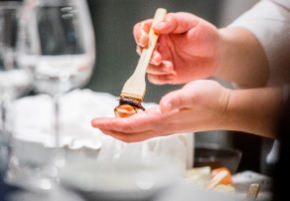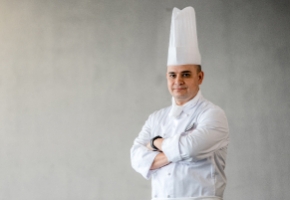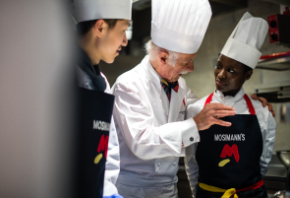- About
- Programs
- Campus Life
- Career Services
- Admissions
- News & Events
- Alumni
Harvest Traditions: From Pongal to Thanksgiving
Discover harvest festival traditions and recipes from Oktoberfest to Thanksgiving. Explore global flavors and seasonal celebrations. Read more today!
Key Takeaways
- Harvest festivals celebrate agricultural abundance and community gratitude across cultures worldwide.
- Common elements include communal feasts, symbolic foods representing prosperity, and rituals of Thanksgiving.
- Major celebrations include Oktoberfest (Germany), Thanksgiving (North America), Mid-Autumn Festival (East Asia), Pongal (India), Chuseok (Korea), and others.
- Traditional foods reflect local crops, seasonal availability, and cultural symbolism passed through generations.
When autumn arrives and fields yield their bounty, communities worldwide pause to celebrate. Harvest festival traditions unite people across continents through shared themes: gratitude for abundance, recognition of hard work, and the joy of gathering around seasonal foods that mark the transition from summer's plenty to winter's rest.
These celebrations take vastly different forms depending on geography, religion, and agricultural cycles. Yet beneath regional variations lies a universal human impulse: to acknowledge the earth's gifts, strengthen community bonds, and preserve culinary traditions that connect past generations to present tables. Understanding harvest festival traditions means exploring how food becomes culture, and celebration becomes heritage.
What Are Harvest Festivals?
Harvest festivals are seasonal celebrations that mark the successful gathering of crops and the transition from growing season to winter. They are rooted in agricultural necessity and have evolved from ancient agrarian societies' need to acknowledge nature's cycles, honor deities or natural forces, and prepare communities for leaner months ahead.
Some common features that unite diverse harvest traditions include:
Start Your Culinary Journey
Learn the art of cooking in a world-class environment
- Community feasts: Shared meals featuring seasonal abundance
- Rituals of gratitude: Religious prayers, toasts, or symbolic offerings
- Symbolic foods: Specific dishes representing prosperity, fertility, or good fortune
- Preservation activities: Canning, fermenting, and storing foods for winter
- Entertainment and competition: Games, music, and contests
The timing varies by hemisphere and climate. Northern Europe celebrates in September-October after the grain harvests. Tropical regions may have multiple harvest periods aligned with different crops.
Modern urban populations may feel disconnected from agricultural rhythms, yet harvest festival traditions persist because they fulfill deeper social needs: gathering family, pausing to appreciate abundance, and maintaining cultural identity through food.
Major Harvest Festivals Around the World
From beer halls in Bavaria to family tables in Massachusetts, harvest celebrations showcase humanity's diverse ways of honoring the land's bounty. Each tradition reflects local ingredients, historical influences, and cultural values passed through generations.
Some of the major harvest festivals around the world are:
Oktoberfest (Germany)
What began as a royal wedding celebration in Munich in 1810 evolved into the world's largest beer festival. Still, Oktoberfest remains deeply connected to Bavarian harvest traditions. Held late September through early October, it often coincides with hop harvests and grain availability for brewing.
The festival's culinary identity centers on hearty, satisfying foods that pair with beer and reflect German agricultural abundance. Traditional Oktoberfest dishes include pretzels (soft, oversized, salted), bratwurst and other sausages showcasing pork butchering traditions, roast chicken (half chickens are standard festival fare), pork knuckle, schnitzel, and potato-based sides like potato salad or dumplings.
While modern Oktoberfest emphasizes tourism and celebration, its roots honor Bavarian agricultural cycles and the community-building power of shared food and popular drinks.
Thanksgiving (United States & Canada)
North American Thanksgiving blends indigenous harvest celebrations, European autumn festivals, and specific historical narratives about colonial-era cooperation. Canadian Thanksgiving occurs on the second Monday of October, closer to actual harvest completion in northern climates. American Thanksgiving falls on the fourth Thursday of November, tied to a 1621 feast between Plymouth colonists and Wampanoag people.
Modern celebrations center on family gatherings and specific traditional foods: the classic roast turkey, mashed potatoes and gravy, stuffing or dressing (bread-based, often with sage, celery, onions), cranberry sauce, green bean casserole, sweet potato or yam dishes, and pumpkin pie as a quintessential autumn dessert.
In general, Thanksgiving emphasizes gratitude, family reunion, and taking pause before winter's onset. The holiday's complex history, including its problematic colonial narratives, has led to evolving conversations about indigenous perspectives and a more accurate historical understanding.
Mid-Autumn festival (China, Vietnam, East Asia)
The Mid-Autumn Festival, celebrated on the 15th day of the eighth lunar month (typically September or early October), honors the harvest moon at its fullest and brightest. This ancient celebration predates written records, with roots in moon worship and agricultural Thanksgiving.
Central traditions include:
- Mooncakes: Dense pastries filled with lotus seed paste, red bean, or other sweet fillings, often containing salted egg yolks representing the full moon.
- Family reunions: The round moon symbolizes completeness and family unity, making this a time for gathering.
- Moon-gazing: Families gather outdoors to appreciate the full moon's beauty.
- Lantern displays: Colorful lanterns light streets and homes, especially delighting children.
Round foods dominate the festival, representing unity and completeness. Besides mooncakes, families serve pomelos (large citrus fruits), taro, lotus root, and other round or circular foods. Tea accompanies mooncakes, cutting their richness.
Regional variations exist, like the Vietnamese Tết Trung Thu, which emphasizes children with lantern processions and lion dances, and many Chinese celebrations vary by province. The festival's endurance across millennia and modern diaspora communities demonstrates how food traditions maintain cultural identity across generations and geographies.
Pongal (India – Tamil Nadu)
Pongal, a four-day Tamil harvest festival in mid-January, celebrates the rice harvest and honors the sun god Surya for agricultural abundance. The name comes from a dish of the same name—rice boiled with milk and jaggery until it overflows the pot, symbolizing prosperity.
The festival unfolds across four days:
- Bhogi Pongal: Discarding old items, cleaning homes
- Surya Pongal: Main celebration with Pongal dish preparation
- Mattu Pongal: Honoring cattle essential to farming
- Kaanum Pongal: Family outings and socializing
Pongal emphasizes the agricultural community, the relationship between humans, animals, and land, and gratitude expressed through food preparation and sharing.
Chuseok (South Korea)
Chuseok, often called "Korean Thanksgiving," occurs on the 15th day of the eighth lunar month (same as Mid-Autumn Festival, reflecting shared cultural roots). This three-day celebration honors ancestors, gathers extended families, and celebrates the autumn harvest.
Traditional foods prepared for Chuseok include:
- Songpyeon: Crescent-shaped rice cakes filled with sweetened sesame seeds, chestnuts, or red beans, steamed over pine needles
- Bulgogi: Marinated grilled beef
- Jeon: Savory pancakes made with various vegetables, seafood, or meat
- Fresh fruit: Especially Korean pears, apples, and persimmons from the autumn harvest
- Kimchi: Various types, including fresh autumn kimchi
The holiday begins with charye, ancestral memorial rites where families prepare elaborate tables of food as offerings. After the ceremonies, families share the feast together. Songpyeon-making becomes a family activity, and legend has it that those who shape beautiful songpyeon will have beautiful children or find good spouses.
Chuseok involves massive travel as people return to ancestral hometowns, creating one of the world's largest annual human migrations. The holiday balances solemn ancestral respect with joyful family reunion, all centered on foods representing autumn's abundance.
Lammas / Lughnasadh (UK, Ireland, Celtic Tradition)
Lammas (August 1 or early August) marks the first harvest in Celtic and Anglo-Saxon traditions, specifically, the grain harvest. The name derives from "loaf mass," referring to bread blessed in Christian services, though pre-Christian roots honor the Celtic god Lugh.
This early harvest festival focuses on bread and grains. Traditional activities include baking loaves from the first wheat, community feasts, country fairs with agricultural competitions, and bread offerings at churches or symbolic locations.
Unlike most autumn harvest festivals, which celebrate abundance, Lammas marks transition and centers on gratitude for grain while acknowledging more harvesting ahead. Bread symbolizes transformation from raw grain to nourishment through human skill and labor.
Modern Lammas celebrations have revived among Pagan communities and those interested in agricultural heritage. Farmers' markets, bread-baking workshops, and heritage grain festivals echo traditional themes of honoring the first fruits of harvest and the skills that transform crops into sustenance.
Erntedankfest (Germany, Switzerland, Austria)
Erntedankfest, celebrated on the first Sunday of October in German-speaking regions, is a Christian harvest thanksgiving with pre-Christian agricultural roots. Protestant and Catholic churches hold special services featuring harvest crowns (wreaths made from grain, vegetables, and fruits), processions with decorated harvest wagons, and altar displays of seasonal abundance.
Traditional foods include:
- Freshly baked breads, especially braided loaves
- Hearty stews featuring autumn vegetables
- Root vegetables: potatoes, carrots, turnips, beets
- Apples and apple-based dishes
- Locally produced cheeses and dairy
- Seasonal game meats
The festival emphasizes community gratitude and practical preparation for winter. Church services include prayers of thanks, and donated harvest goods often go to those in need, reinforcing themes of sharing abundance.
Tsukimi (Japan)
Tsukimi ("moon-viewing") celebrates the autumn moon's beauty. It occurs on the same lunar calendar date as the Mid-Autumn Festival. While less focused on harvest thanksgiving than other traditions, Tsukimi acknowledges autumn abundance and the aesthetic appreciation of seasonal change central to Japanese culture.
Tsukimi traditions include:
- Tsukimi dango: Round rice dumplings stacked in pyramids, representing the full moon
- Seasonal offerings: Taro, chestnuts, persimmons, edamame
- Pampas grass: Displayed as decoration, evoking autumn fields
- Moon-viewing: Gathering outdoors or by windows to appreciate the full moon's beauty
The festival blends Shinto gratitude for harvests with Buddhist and aesthetic traditions emphasizing nature's transient beauty (mono no aware). Tsukimi's quieter, more contemplative nature contrasts with more boisterous harvest celebrations elsewhere, reflecting Japanese cultural values of aesthetic refinement and seasonal awareness.
Cultural Importance of Food in Harvest Traditions
Sharing food has long been central to building community bonds. Preparing and eating together requires cooperation and creates shared experiences that strengthen social ties. In the past, harvest feasts often involved entire communities: neighbors helped bring in crops, then gathered at the table to celebrate. This reciprocity was essential for survival in agricultural societies. Even today, modern harvest gatherings echo this function by reuniting extended families and friends, reminding people of their interdependence.
Recipes serve as vessels of heritage, transmitting traditions across generations. When grandmothers teach grandchildren how to make mooncakes for the Mid-Autumn Festival or Pongal for the Tamil harvest, they pass down far more than cooking skills. They share cultural knowledge, language, family stories, and connections to ancestral homelands. For immigrant families, these harvest dishes become especially meaningful, anchoring them to origins and identities that might otherwise fade with time.
Symbolic foods also embody gratitude and shared values. Round pastries during moon festivals symbolize unity, while first fruits in ancient traditions acknowledged humanity's dependence on nature's gifts. Elaborate preparations demonstrate respect for both the occasion and those gathered, showing that food is not just nourishment but a statement of abundance, generosity, skill, and connection to the land.
As Chef Laurent Suaudeau, Maître Cuisinier de France, explains:
It is important that [students] grow a knowledge and appreciation of cuisine from farm to table. The sources and the history of cuisine are the foundation stones from which they will develop their own style.
This perspective reflects the enduring value of harvest traditions. In teaching future generations about food, including older customs, we equip them to engage with modern culinary practices while understanding the traditions that shaped them. We honor the past while engaging with the present, similar to how harvest traditions continue to nourish both culture and cuisine.
Celebrating the Season Through Food
Harvest festival traditions remind us that food is never just fuel. It's culture, memory, and meaning made edible. They teach us to pause and appreciate abundance rather than taking it for granted, and they demonstrate that despite vast cultural differences, humans worldwide share fundamental impulses to mark seasons, gather loved ones, and say thank you through the universal language of shared meals.
At Culinary Arts Academy, we carry this same spirit into our teaching. The Bachelor of Arts in Culinary Arts degree follows this approach by teaching culinary techniques alongside food safety, international cuisines, food history, and cultural influences that have shaped global gastronomy. Students gain a deep understanding of how tradition, creativity, and science combine to define the modern culinary landscape.
Frequently Asked Questions
What is the oldest known harvest festival in the world?
Ancient Egyptian harvest festivals honoring Min (fertility god) date to at least 3000 BCE, though similar celebrations likely existed earlier across agricultural societies worldwide.
Which harvest festivals are still celebrated in modern cities?
Oktoberfest, Thanksgiving, Mid-Autumn Festival, Chuseok, and Pongal remain widely celebrated even in urban areas, adapted from agricultural roots to cultural and family traditions.
Are there vegetarian or vegan harvest festival recipes?
Yes! Many traditional dishes are naturally plant-based (Pongal, mooncakes, songpyeon, roasted vegetables), and others easily adapt by substituting ingredients while preserving cultural significance.
Interested in becoming a world-class chef? Learn more about Culinary Arts Academy Switzerland. Download our brochure.






















